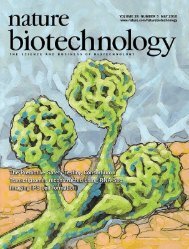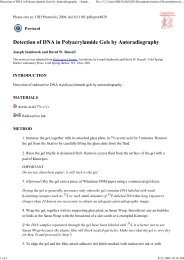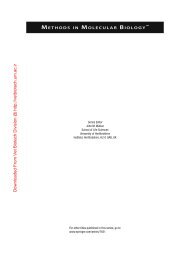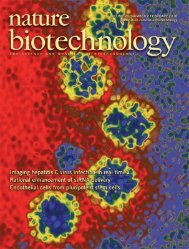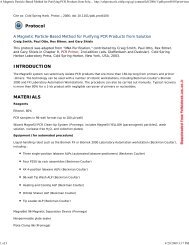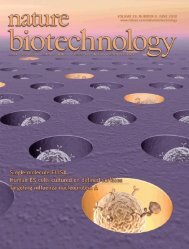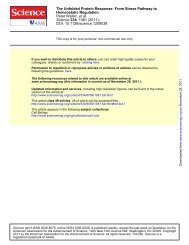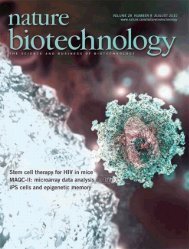Create successful ePaper yourself
Turn your PDF publications into a flip-book with our unique Google optimized e-Paper software.
RESEARCH ARTICLE<br />
handful of trajectories and our initial interpretations.<br />
Many more fossils (Fig. 5 and fig. S13),<br />
with shapes no less intriguing, beckon:<br />
(i) Peaks in “influenza” correspond with<br />
dates of known pandemics, suggesting the value<br />
of culturomic methods for historical epidemiology<br />
(35) (Fig. 5A and fig. S14).<br />
(ii) Trajectories for “the North”, “the South”,<br />
and finally “the enemy” reflect how polarization<br />
of the states preceded the descent into the Civil<br />
War (Fig. 5B).<br />
(iii) In the battle of the sexes, the “women”<br />
are gaining ground on the “men” (Fig. 5C).<br />
(iv) “féminisme” made early inroads in<br />
France, but the United States proved to be a more<br />
fertile environment in the long run (Fig. 5D).<br />
(v) “Galileo”, “Darwin”,and“Einstein” may<br />
be well-known scientists, but “Freud” is more<br />
deeply ingrained in our collective subconscious<br />
(Fig. 5E).<br />
(vi) Interest in “evolution” was waning when<br />
“DNA” came along (Fig. 5F).<br />
(vii) The history of the American diet offers<br />
many appetizing opportunities for future research;<br />
the menu includes “steak”, “sausage”, “ice cream”,<br />
“hamburger”, “pizza”, “pasta”, and “sushi”<br />
(Fig. 5G).<br />
(viii) “God” is not dead but needs a new<br />
publicist (Fig. 5H).<br />
These, together with the billions of other<br />
trajectories that accompany them, will furnish a<br />
great cache of bones from which to reconstruct<br />
the skeleton of a new science.<br />
References and Notes<br />
1. E. O. Wilson, Consilience (Knopf, New York, 1998).<br />
2. D. Sperber, Man (London) 20, 73 (1985).<br />
3. S. Lieberson, J. Horwich, Sociol. Methodol. 38, 1 (2008).<br />
4. L. L. Cavalli-Sforza, W. Marcus, X. Feldman, Cultural<br />
Transmission and Evolution (Princeton Univ. Press,<br />
Princeton, NJ, 1981).<br />
5. P. Niyogi, The Computational Nature of Language<br />
Learning and Evolution (MIT, Cambridge, MA, 2006).<br />
6. G. K. Zipf, The Psycho-biology of Language<br />
(Houghton Mifflin, Boston, 1935).<br />
7. Materials and methods are available as supporting<br />
material on <strong>Science</strong> Online.<br />
8. E. S. Lander et al.; International Human Genome<br />
Sequencing Consortium, Nature 409, 860 (2001).<br />
9. A. W. Read, Am. Speech 8, 10 (1933).<br />
10. Webster's Third New International Dictionary of the<br />
English Language, Unabridged, P. B. Gove, Ed.<br />
(Merriam-Webster, Springfield, MA, 1993).<br />
11. The American Heritage Dictionary of the English<br />
Language, Fourth Edition, J. P. Pickett, Ed.<br />
(Houghton Mifflin, Boston, 2000).<br />
12. Oxford English Dictionary, J. A. Simpson, E. S. C. Weiner,<br />
M. Proffitt, Eds. (Clarendon, Oxford, 1993).<br />
13. J. Algeo, A. S. Algeo, Fifty Years among the New Words:<br />
A Dictionary of Neologisms, 1941–1991<br />
(Cambridge Univ. Press, Cambridge, 1991).<br />
14. S. Pinker, Words and Rules (Basic Books, New York,<br />
1999).<br />
15. Anthony S. Kroch, Language Variation Change 1,<br />
199 (1989).<br />
16. J. L. Bybee, Language 82, 711 (2006).<br />
17. E. Lieberman, J. B. Michel, J. Jackson, T. Tang,<br />
M. A. Nowak, Nature 449, 713 (2007).<br />
18. B. Milner, L. R. Squire, E. R. Kandel, Neuron 20,<br />
445 (1998).<br />
19. H. Ebbinghaus, Memory: A Contribution to Experimental<br />
Psychology (Dover Publications, New York, 1987).<br />
20. M. Halbwachs, On Collective Memory, Lewis A. Coser,<br />
transl. (Univ. of Chicago Press, Chicago, 1992).<br />
21. S. Ulam, Bull. Am. Math. Soc. 64, 1 (1958).<br />
22. L. Braudy, The Frenzy of Renown: Fame & Its History<br />
(Vintage Books, New York, 1997).<br />
23. Wikipedia, 23 August 2010, www.wikipedia.org/.<br />
24. Encyclopaedia Britannica, D. Hoiberg, Ed.<br />
(Encyclopaedia Britannica, Chicago, 2002).<br />
25. Censorship: 500 Years of Conflict, V. Gregorian, Ed.<br />
(New York Public Library, New York, 1984).<br />
26. W. Treß, Wider Den Undeutschen Geist:<br />
Bücherverbrennung 1933 (Parthas, Berlin, 2003).<br />
27. G. Sauder, Die Bücherverbrennung: 10. Mai 1933<br />
(Ullstein, Frankfurt am Main, Germany, 1985).<br />
28. S. Barron, P. W. Guenther, Degenerate Art: The Fate of<br />
the Avant-garde in Nazi Germany (Los Angeles County<br />
Museum of Art, Los Angeles, 1991).<br />
29. Google News Archive Search, http://news.google.com/<br />
archivesearch.<br />
30. Digital Scriptorium, www.scriptorium.columbia.edu.<br />
31. Visual Eyes, www.viseyes.org.<br />
32. ARTstor, www.artstor.org.<br />
33. Europeana, www.europeana.eu.<br />
34. Hathi Trust Digital Library, www.hathitrust.org.<br />
35. J. M. Barry, The Great Influenza: The Epic Story of the<br />
Deadliest Plague in History (Viking Press, New York, 2004).<br />
36. J.-B.M. was supported by the Foundational Questions in<br />
Evolutionary Biology Prize Fellowship and the Systems<br />
Biology Program (Harvard Medical School). Y.K.S. was<br />
supported by internships at Google. S.P. acknowledges<br />
support from NIH grant HD 18381. E.L.A. was supported<br />
by the Harvard Society of Fellows, the Fannie and<br />
John Hertz Foundation Graduate Fellowship, a National<br />
Defense <strong>Science</strong> and Engineering Graduate Fellowship, an<br />
NSF Graduate Fellowship, the National Space Biomedical<br />
Research Institute, and National Human Genome Research<br />
Institute grant T32 HG002295. This work was supported by<br />
a Google Research Award. The Program for Evolutionary<br />
Dynamics acknowledges support from the Templeton<br />
Foundation, NIH grant R01GM078986, and the Bill and<br />
Melinda Gates Foundation. Some of the methods described<br />
in this paper are covered by U.S. patents 7463772 and<br />
7508978. We are grateful to D. Bloomberg, A. Popat,<br />
M. McCormick, T. Mitchison, U. Alon, S. Shieber,<br />
E.Lander,R.Nagpal,J.Fruchter,J.Guldi,J.Cauz,C.Cole,<br />
P. Bordalo, N. Christakis, C. Rosenberg, M. Liberman,<br />
J. Scheidlower, B. Zimmer, R. Darnton, and A. Spector for<br />
discussions; to C.-M. Hetrea and K. Sen for assistance with<br />
Encyclopaedia Britannica's database; to S. Eismann,<br />
W. Treß, and the City of Berlin Web site (berlin.de) for<br />
assistance in documenting victims of Nazi censorship; to<br />
C. Lazell and G. T. Fournier for assistance with annotation;<br />
to M. Lopez for assistance with Fig. 1; to G. Elbaz and<br />
W. Gilbert for reviewing an early draft; and to Google’s<br />
library partners and every author who has ever picked up a<br />
pen, for books.<br />
Supporting Online Material<br />
www.sciencemag.org/cgi/content/full/science.1199644/DC1<br />
Materials and Methods<br />
Figs. S1 to S19<br />
References<br />
27 October 2010; accepted 6 December 2010<br />
Published online 16 December 2010;<br />
10.1126/science.1199644<br />
182<br />
14 JANUARY 2011 VOL 331 SCIENCE www.sciencemag.org




